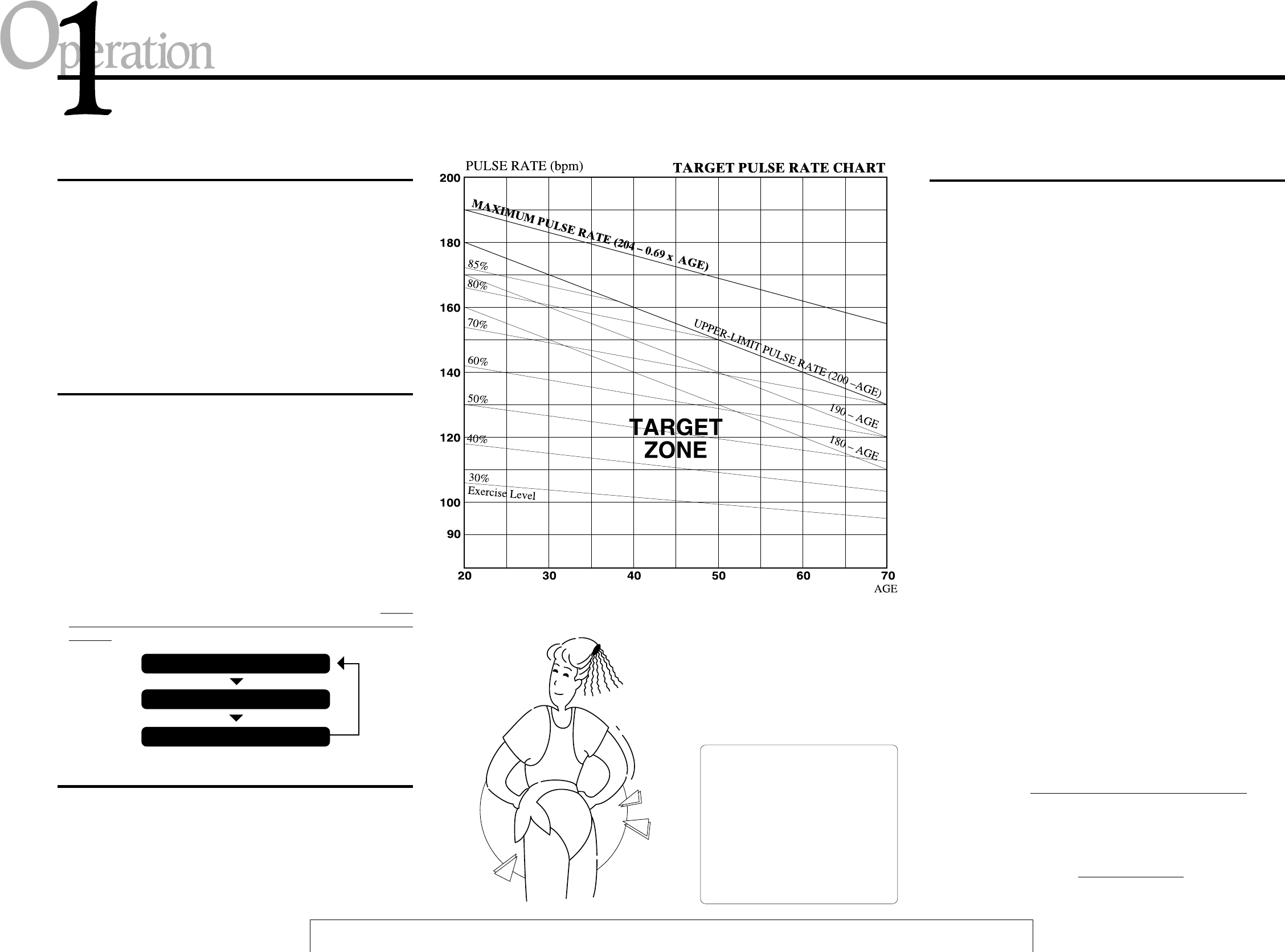
22
Your strength level and training index (1)
Purpose of Exercise
• Have you ever been out of breath after climbing a flight of stairs or
after a brisk walk? When we are walking, running and even sleeping,
our body is taking in oxygen and generating energy. Oxygen taken in
by the lungs is sent to the entire body via the circulatory system. If the
function of the circulatory system , i.e. aerobic power, is insufficient,
we may experience being "out of breath" or experience yet other
physical problems.
• We therefore perform "sports for the heart" (aerobic exercise), which
causes the heart to work a little more a few times a week, thus increas-
ing the oxygen supply to the body via the circulatory system. The pur-
pose of exercise with the Ergociser is to improve both your physical
strength and the functioning of the circulatory system: to improve our
aerobic power.
Exercise Plan
• To effectively perform "sports for the heart" and to improve your
aerobic power, it is necessary to exercise according to your age and
physical fitness. If exercise exceeds your physical fitness level you only
injure your body. On the other hand, if the exercise is insufficient, a
positive effect cannot be expected.
• The Ergociser EC-1600 has 6 types of computer-controlled programs.
One program is the "Aerobic Power Measurement Program". This test
program evaluates your physical fitness level, while the other 5 pro-
grams are for actual exercise.
• The "Aerobic Power Measurement Program" evaluates your physical
fitness level so that you can determine the training index and begin
exercise based on the measured result. After exercising for a while
(about 3 months), you become aware of the effect on your body. Test
your physical fitness level again and gradually set a higher training in-
dex, thus maintaining and improving your physical fitness level. A spe-
cial feature of the Ergociser™ EC-1600 is that it combines testing with
exercise.
Aerobic Power Measurement
Exercise Planning
Exercise
Exercise Frequency and Time
• At least 15 minutes are required for one exercise period, however if
possible a 20 ~ 30 minute period is even better.
• To maintain your present condition, exercise at lease twice a week, 3
times a week would improve your condition even more. The ideal how-
ever is to exercise every day or 5 ~ 6 times a week.
23
Exercise Level (%) = x 100
Note : You could also make up your
target pulse rate more simply by
deducting your age from a certain
figure. For a beginner, for in-
stance, it is recommendable to
start with [160–age (approx.
30~50% depending on your age)],
and gradually proceed to higher
level such as [180–age (approx.
50~70%)]. It would be ideal to
aim at [190–age] eventually.
Glossary of Terms
• Maximum Heart Rate
The heart rate increases according to the intensity of exercise, there is
however a limit. The maximum heart rate that a person can sustain is
called the "maximum heart rate". Generally the heart rate declines as we
get older, this differs however between individuals, and is largely due to
how much one exercises.
• Difference Between the Heart Rate and Pulse Rate
The heart rate is the rate of the heart beat per minute measured by an
electrocardiograph. On the other hand, the pulse rate is measured as fol-
lows.
1)By palpating an artery near the skin surface, such as the carotid artery,
measure the pulse count of a blood vessel.
2)Transmit a sensor light to an earlobe or finger tip, and measure the
pulse count via the subtle changes of the sensor light transmission
caused by the heart beat.
Although the measurement principle and method are different, both the
heart and pulse rates have the same value per minute, and are therefore
regarded as synonymous.
Since earlobes move very little during exercise and are not influenced
very much by physical movement, it is appropriate to use an earlobe to
measure the pulse rate during exercise. The Ergociser EC-1600 therefore
measures the pulse rate by detecting changes in the circulation of the ear-
lobe.
• Pulse Limit
As a standard maximum heart rate, "220–Age", "204–0.69 x Age", etc.
are used. With the Ergociser EC-1600, a somewhat lower value is used:
"200–Age". This pulse limit allows a person to safely exercise.
• Target Pulse Rate
The pulse rate to maintain during exercise as a target is called the "target
pulse rate". In the "Auto training" program, this pulse rate is automati-
cally maintained. However, even with other programs, always be con-
scious of your target pulse rate during exercise. Refer to the illustration
on the left.
• Exercise Level Based on the Pulse Rate
The pulse rate increases according to the intensity of the exercise. In
other words, the pulse rate during exercise is a barometer for the exercise
level. The exercise level can be determined in percentages by the follow-
ing formula.
Pulse rate during exercise – Pulse rate at rest
Maximum heart rate – Pulse rate at rest
Therefore, if you want to discern the target of the exercise level from the
pulse rate (target pulse rate), you can calculate as follows.
Target pulse rate = (maximum heart rate – pulse rate at rest)
x + pulse rate at rest
Exercise Level (%)
100


















